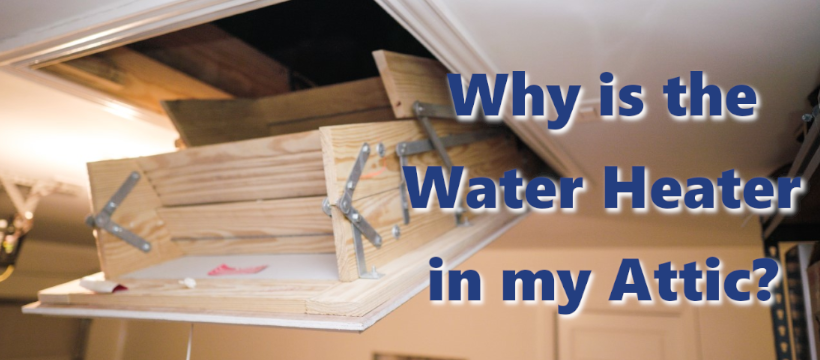Moving a water heater from the attic to the garage improves safety and accessibility. It also reduces potential water damage risks.
Relocating your water heater to the garage can provide numerous benefits. It enhances the safety of your home by minimizing the risk of leaks and water damage, which are more difficult to manage in an attic. Accessibility is also significantly improved, making maintenance and repairs easier and more efficient.
This move can increase the lifespan of your water heater and reduce energy costs by improving its operating environment. Proper planning and professional installation are essential to ensure a smooth transition. Consider consulting with a licensed plumber to handle the relocation safely and according to local building codes.

Credit: www.jdprecisionplumbing.com
Page Contents
Benefits Of Relocation
Relocating the water heater to the garage can free up valuable attic space for storage. It also reduces the risk of water damage to your home’s interior.
Enhanced Safety
Relocating a water heater to the garage can reduce fire hazards. The attic space often has insulation and other materials that can catch fire. Water leaks in the attic can cause ceiling damage. In the garage, leaks are less likely to cause major damage.
Improved Accessibility
Maintenance tasks become easier with the water heater in the garage. Homeowners can access it without climbing stairs or using ladders. Repairs and replacements are quicker and safer. Professionals find it easier to work on units in the garage. This can reduce service costs.

Credit: www.lowes.com
Planning The Move
Check the garage for enough space for the water heater. Measure the dimensions carefully. Make sure there is room for maintenance and access. Clear any items that may block the area. Ensure the space is safe and dry. Look for a spot near water and power sources. This helps in easy installation.
Talk to plumbing experts about the move. They can give the best advice. Check if any permits are needed. Electricians can help with wiring requirements. Professionals ensure safety and code compliance. Hiring experts can save time and avoid mistakes. Always get multiple quotes for the best price.
Required Tools
Gather these basic tools before starting. You will need a screwdriver to remove screws. A wrench is necessary for loosening and tightening nuts. Have a pipe cutter ready for cutting pipes. Use a measuring tape for accurate measurements. A level will help ensure straight lines. Keep a flashlight handy for better visibility.
Some specialized equipment is also required. An appliance dolly helps move the water heater. Pipe insulation is essential to prevent heat loss. Use a soldering kit for joining metal pipes. A water pump will help to remove excess water. Safety gloves protect your hands from injuries. Safety goggles safeguard your eyes.
Preparation Steps
First, turn off the power or gas supply to the water heater. Next, connect a hose to the drain valve at the bottom of the tank. Run the other end of the hose to a floor drain or outside. Open the drain valve and let the water flow out. Make sure to open a hot water faucet to help the water drain faster. This will also prevent a vacuum from forming in the pipes.
Turn off the water supply to the heater. Disconnect the water lines using a wrench. Be careful as some water may still be in the pipes. Next, turn off the gas supply if you have a gas heater. Use a wrench to disconnect the gas line. For an electric heater, turn off the power at the breaker box. Disconnect the electrical wiring. Make sure all utilities are safely disconnected before moving the heater.
Moving The Heater
Relocating a water heater from the attic to the garage enhances safety and accessibility. This move reduces the risk of water damage and simplifies maintenance tasks.
Using A Dolly
First, secure the heater on the dolly with strong straps. This keeps the heater steady and prevents accidents. Next, tilt the dolly back slowly to balance the weight. Move with short, controlled steps. Always keep one hand on the heater for extra safety. Check the pathway for any obstacles. Clear them before starting the move.
Stairs can be tricky when moving a heavy heater. Use sturdy ramps if available. Two people should handle the dolly, one at the top and one at the bottom. Move slowly and communicate with each other. Take breaks if needed. Safety first to avoid injuries.

Credit: m.youtube.com
Installing In The Garage
The water heater should be on a stable surface. Use a drip pan to catch leaks. Keep it away from flammable materials. Ensure there is enough space around it. This helps with maintenance. The heater should be near water and gas lines.
Turn off the main water supply. Connect the cold water inlet to the new heater. Attach the hot water outlet. Reconnect the gas line or electric power. Check for leaks in the connections. Turn on the water supply slowly. Test the heater to ensure it works properly.
Post-move Checklist
Check for any leaks around the water heater. Look at the valves and pipes. Small drips can lead to big problems. A dry floor means no leaks. Use a flashlight to see better. Keep an eye out for any wet spots.
Set the thermostat to the right temperature. Most homes need 120 degrees. Too high can be dangerous. Too low won’t be hot enough. Check the display to make sure it shows the correct setting. Adjust if necessary.
Maintenance Tips
Check the water heater every month. Look for leaks and rust. Make sure all pipes are tight. Listen for any strange noises. Keep the area around the heater clean. Ensure ventilation is working well. Check the temperature settings. Make sure they are not too high. Inspect the pressure relief valve. Test it to ensure it works. Regular inspections help prevent problems.
Flush the tank every six months. Turn off the power or gas. Attach a hose to the drain valve. Let the water flow out. This removes sediment from the tank. Sediment can cause damage over time. Refill the tank after flushing. Turn the power or gas back on. Flushing keeps the heater efficient. It helps the heater last longer.
Frequently Asked Questions
Can I Move A Water Heater From An Attic To A Garage?
Yes, you can move a water heater from an attic to a garage. Ensure proper permits and professional installation.
Can I Move My Water Heater To The Garage?
Yes, you can move your water heater to the garage. Ensure proper ventilation and comply with local building codes.
How Difficult Is It To Relocate A Hot Water Heater?
Relocating a hot water heater can be challenging. It involves plumbing, electrical work, and possible building code compliance. Hiring professionals is recommended.
Is It Expensive To Relocate A Water Heater?
Relocating a water heater can be costly. Prices range from $500 to $2,000, depending on complexity and distance.
Conclusion
Relocating your water heater from the attic to the garage offers numerous benefits. You’ll improve safety and gain extra storage space. It’s a smart move for efficiency and home maintenance. Consider professional help for a smooth transition. Enjoy the enhanced convenience and peace of mind in your newly optimized home.
